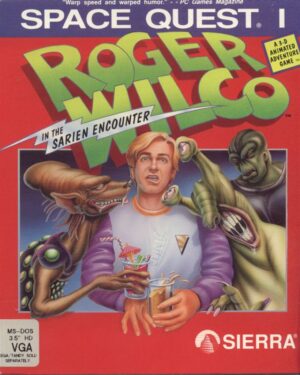Retro Replay Review
Gameplay
Betrayal at Krondor delivers a richly detailed role-playing experience that balances structured narrative with open exploration. The game is divided into nine chapters, each with a clear primary objective but plenty of room to wander the world map, visit towns, hunt for treasure, or pick up side quests. This blend of linear storytelling and optional content gives players the freedom to shape their own adventure and tackle challenges in multiple ways.
(HEY YOU!! We hope you enjoy! We try not to run ads. So basically, this is a very expensive hobby running this site. Please consider joining us for updates, forums, and more. Network w/ us to make some cash or friends while retro gaming, and you can win some free retro games for posting. Okay, carry on 👍)
The party system evolves organically as the story unfolds. You begin with Gorath the renegade moredhel, Locklear the noble swordsman, and Owyn the young magician, each offering distinct skills and personalities. As chapters progress, characters may depart or new allies may join, providing fresh tactical dynamics. This fluid roster keeps combat encounters and dialogue scenes from growing stale, and encourages you to adapt your strategies to new party compositions.
Combat in Betrayal at Krondor takes place on grid-based screens in a classic turn-based fashion. Fighters swing swords or crossbows, while magicians wield staves and weave offensive or defensive spells. Careful management of stamina—drained by attacking or casting—and strategic use of terrain and positioning add layers of depth. Outside of battle, characters can improve individual skills like bartering, stealth, or weapon proficiencies simply by using them, and you can “emphasize” a skill to accelerate its growth for a more customized progression.
Graphics
For its time, Betrayal at Krondor’s visuals were groundbreaking, offering a 3D first-person overworld that heightens immersion in the Kingdom of the Isles. Rolling hills, distant mountains, and settlements appear with a surprising sense of scale, making long journeys feel meaningful. Though low-resolution by modern standards, each vista brims with atmosphere and fuels the feeling that you’re exploring a living, breathing land.
When you enter towns, the game switches to a series of beautifully illustrated static screens. Each location—from bustling taverns and winding alleys to quiet temples—is rendered with care, evoking the medieval fantasy aesthetic of Raymond E. Feist’s novels. While the lack of animated movement can feel static, these detailed backdrops invite players to linger, read NPC dialogue, and soak up the lore in a way that dynamic 3D scenes sometimes cannot match.
Grid-based combat screens adopt a top-down perspective with simple yet effective tilesets. Characters and monsters are represented by clear icons or sprites, and spell effects—flaming fireballs, shimmering ice shards, or protective wards—stand out in vivid color. Although the art is functional rather than flash, it conveys all the tactical information you need and reinforces the game’s strategy-first approach.
Story
Co-written by Raymond E. Feist himself and based on his acclaimed Riftwar saga, Betrayal at Krondor offers a narrative that rivals many contemporary CRPGs. It opens with Gorath, a defected dark elf racing to warn Krondor of an impending moredhel invasion, only to be beset by assassins at every turn. From that tense introduction, you’re plunged headfirst into court intrigue, magical conspiracies, and battles against formidable foes.
Owen Locklear and young magician Owyn join Gorath on this perilous quest, and their evolving camaraderie is a highlight throughout the nine chapters. Feist’s gift for vivid characterization shines as each hero grapples with personal doubts, rivalries, and moral dilemmas. Side quests often enrich the world, revealing hidden histories of the Tsurani, the enigmatic Pantathians, and other denizens of Midkemia.
The chapter structure keeps the story moving at a brisk pace, with each installment presenting a new objective—whether it’s unmasking a traitor in Krondor’s court, infiltrating enemy strongholds, or rescuing key allies. Yet you’re never railroaded: detours to deep forests, haunted ruins, or forgotten vaults yield valuable loot, powerful allies, and even clues that make later encounters more manageable. This flexible storytelling makes replaying individual chapters to uncover every secret a rewarding endeavor.
Overall Experience
Betrayal at Krondor remains a standout classic for fans of narrative-driven, party-based RPGs. Its blend of open-world exploration, strategic turn-based combat, and deep character progression complements a rich, literary storyline that feels lifted straight from Feist’s novels. The game’s deliberate pacing allows you to savor every discovery, from whispered rumors in taverns to the ominous rumble of moredhel war drums.
Though aspects like static town screens and minimalist animations reflect its mid-’90s heritage, those same qualities lend the game a timeless charm. The user interface is straightforward, the spell-casting system is robust, and the freedom to emphasize skills fosters genuine player investment in each character’s growth. Technical requirements are modest, making it accessible on modern systems via emulators or revamped re-releases.
For new players, expect a learning curve in juggling stamina, party roles, and the sometimes cryptic side quests. Veteran CRPG enthusiasts will appreciate the nuanced combat and open-ended exploration, while fans of Feist’s writing will delight in seeing the Riftwar universe brought to life. Whether you’re seeking a nostalgic journey or a challenging fantasy epic, Betrayal at Krondor offers a memorable adventure that stands the test of time.
 Retro Replay Retro Replay gaming reviews, news, emulation, geek stuff and more!
Retro Replay Retro Replay gaming reviews, news, emulation, geek stuff and more!









Reviews
There are no reviews yet.